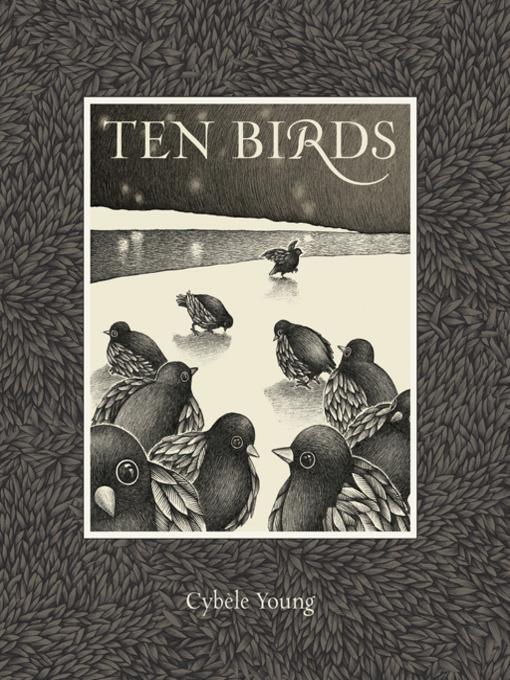
Ten Birds
فرمت کتاب
ebook
تاریخ انتشار
2011
Lexile Score
440
Reading Level
1-2
نویسنده
Cybele Youngناشر
Kids Can Press Ltd.شابک
9781554539420
کتاب های مرتبط
- اطلاعات
- نقد و بررسی
- دیدگاه کاربران
نقد و بررسی

April 18, 2011
Ten black birds appear on a winter night on a snowy riverbank; they are "trying to figure out how to get to the other side of the river." There's a bridge in plain view, but they appear not to see it. Nine birds use the fantastic arrangements of wood, string, hardware, pulleys, and fans standing on the riverbank to cross the river. The contraptions are shaped like the numbers one through 10; each bird reassembles its contraption into something new. One turns the wooden number "9" into a pair of stilts: "The one they called âBrilliant' knew how to cross. Marching, he left NINE behind." The next uses the 8-shaped pair of wheels to build a water-paddled unicycle: "The one they called âQuite Advanced' engineered her way." Only the last bird does the obvious thing and plods across the bridge; ironically, his name is "Needs Improvement." Young's (Jack Pine) meticulously drafted pen-and-ink artwork, reminiscent of M.C. Escher, grabs most of the attention, while the message about the clearest solution being the best one is somewhat blunted by the wonderfully creative and complex alternatives she invents. All ages.

April 1, 2011
K-Gr 3-This book's pen-and-ink landscapes with hidden numbers recall Arthur Geisert's etchings in Pigs from 1 to 10 (Houghton, 1992). While Young's scenes are simpler, the mood created by the cream and black palette is similar, and both artists are preoccupied with contraptions and camouflage. Here, the opening spreads are wordless. From a vantage point behind 10 plump, black birds, viewers watch as the creatures proceed across a wide expanse toward a river and bridge visible below the high horizon line. Their destination is to a collection of odd assemblages made of wheels, kite string, an electric fan, and other items. The apparently deliberate arrangement invites close scrutiny and the inkling that the groupings might spell something. The text initiates a countdown, descending from 10, as each bird chooses some mechanism to propel it across the river: "The one they called 'Brilliant' knew how to cross. Marching, he left NINE behind." When the wooden planks the bird fashioned into stilts are removed, the shape of numeral 9 remains-along with his 9 companions. So it goes as "Quite Advanced," "Highly Satisfactory," etc., cross. Finally "Needs Improvement" walks across the bridge, his footprints forming a zero. As they abandon their devices (creating new possibilities) and prepare to fly away, the birds glance back at the numbers. Why didn't they fly over? Is this a commentary on intelligence vs. creativity? A plot device to trip the numeric sequence? Young students will ponder such questions while gleaning inspiration for their own inventions.-Wendy Lukehart, Washington DC Public Library
Copyright 2011 School Library Journal, LLC Used with permission.

May 1, 2011
Grades 1-3 Ten small black birds approach a river whose bank is decorated with a series of Rube Goldbergstyle apparatuses. One by one, each bird, identified by a glowing name (Brilliant, Extraordinary), uses something from an apparatus to engineer its own passage across the river, while the remaining parts form into a numeral that indicates how many birds remain. Finally, after each apparatus is spent, the last bird, Needs Improvement, walks across an adjacent bridge, which was visible throughout the other, more complicated triumphs. Youngs scratchy pen-and-ink drawings on buff paper recall Arthur Geiserts intaglio prints in style and composition, and the crisp, straightforward imagery provides a simple foil for the abstract, layered complexity of the story. Young children will enjoy seeing the numbers revealed and will look for them in the original configurations of hardware and tackle. But the artists explorations of identity, expectation, and possibility will captivate an audience of older children ready to engage with the creative interplay between imagery and meaning.(Reprinted with permission of Booklist, copyright 2011, American Library Association.)

























دیدگاه کاربران